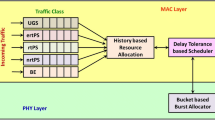Abstract
The IEEE 802.16 is a leading technology for Broadband Wireless Access (BWA), where a Base Station (BS) provides a set of Subscriber Stations (SSs) with first-mile network access. Each SS has multiple connections directed to the BS, which are assigned bandwidth on a demand basis. Specifically, the BS allocates part of the channel as request slots, which are accessed by best-effort connections in a random access manner to transmit bandwidth requests. Although bandwidth requests sent by different SSs may collide the standard does not specify an explicit acknowledgment mechanism. This, and the bandwidth being assigned by the BS to each SS as a whole, may lead to critical inconsistencies between the perception of the SSs’ requirements at the BS and the actual SSs’ requirements, which in turn may entail SS service disruption. While the standard suggests that an SS should regularly update the BS about the backlog of its connections, the algorithm to do so is left unspecified. In this paper we propose a simple, yet effective, mechanism to be employed by the SSs, called Bandwidth Request Reiteration (BR2), which prevents deadlock from occurring. Using detailed packet-level simulation, we compare BR2 to an alternative approach based on timeout, and show that BR2 achieves better performance, in terms of the average transfer delay, while it does not incur a significant additional overhead, in terms of MAC signaling.











Similar content being viewed by others
Notes
Patent pending.
The actual uplink grant duration will then be computed by the BS based on the burst profile currently used by the SS for which the grant is intended to transmit data.
The Grant Per Connection (GPC) mode for uplink bandwidth granting has been definitely removed from the standard since the 2004 release of IEEE 802.16 [8]. Therefore, even though GPC would avoid, deadlock due to collision of bandwidth requests as well, we do not take it into consideration.
References
Baugh, C. R., Huang, J., Schwartz, R., & Trinkwon, D. (2001). Traffic model for 802.16 TG3 MAC/PHY simulations. IEEE 802.16 Broadband Wireless Access Working Group, March 2, 2001.
Cicconetti, C., Eklund, C., Lenzini, L., & Mingozzi, E. (2006). Quality of service support in IEEE 802.16 networks. IEEE Network Magazine, 20(2), 50–55. doi:10.1109/MNET.2006.1607896.
Cicconetti, C., Erta, A., Lenzini, L., & Mingozzi, E. (2007). Performance evaluation of the IEEE 802.16 MAC for QoS support. Transactions on Mobile Computing, 6(1), 26–38. doi:10.1109/TMC.2007.250669.
Ghosh, A., Wolter, D. R., Andrews, J. G., & Chen, R. (2005). Broadband wireless access with WiMax/802.16: Current performance benchmarks and future potential. IEEE Communications Magazine, 43(2), 129–136. doi:10.1109/MCOM.2005.1391513.
Gusak, O., Oliver, N., & Sohraby, K. (2004). Performance evaluation of the 802.16 medium access control layer. Lecture notes on computer science (Vol. 3280, pp. 228–237). Berlin: Springer.
Hoymann, C. (2005). Analysis and performance evaluation of the OFDM-based metropolitan area network IEEE 802.16. Computer Networks (Elsevier), 49(3), 341–363. doi:10.1016/j.comnet.2005.05.008.
IEEE 802.11. (2005). Wireless LAN Medium Access Control and physical layer specifications. Medium Access Control (MAC) Quality of Service (QoS) enhancements. December 2005.
IEEE 802.16-2004. (2004). IEEE Standard for Local and Metropolitan Area Networks—Part 16: Air interface for Fixed Broadband Wireless Access systems. October 2004.
Law, A. M., & Kelton, W. D. (2000). Simulation modeling and analysis (3rd ed.). Boston, MA: McGraw-Hill.
Lee, H.-W., & Seo, J.-B. (2007). Queueing performance of IEEE 802.16 random access protocol with bulk transmissions. In Proceedings of ICC 2007, Glasgow, Scotland, UK, June 24–28, pp. 5963–5968.
Ni, Q., Vinel, A., Xiao, Y., Turlikov, A., & Jiang, T. (2007). Investigation of bandwidth request mechanisms under point-to-multipoint mode of WiMAX networks. IEEE Communications Magazine, 45(5), 132–138. doi:10.1109/MCOM.2007.358860.
Oh, S.-M., & Kim, J.-H. (2005). The analysis of the optimal contention period for Broadband Wireless Access network. In Proceedings of PerCom 2005, Kauai, USA, March 8–12, 2005, pp. 215–219.
Staehle, D., & Pries, R. (2007). Comparative study of the IEEE 802.16 random access mechanisms. In Proceedings of NGMAST 2007, Cardiff, Wales, UK, September 12–14, pp. 334–339.
Zhang, Y., & Costa, E. (2006). An efficient usage of contention period for bandwidth request. In Proceedings of European Wireless 2006, Athens, Greece, April 2–5, 2006.
Author information
Authors and Affiliations
Corresponding author
Rights and permissions
About this article
Cite this article
Cicconetti, C., Lenzini, L. & Mingozzi, E. A bandwidth request reiteration mechanism for IEEE 802.16 wireless networks. Wireless Netw 16, 731–742 (2010). https://doi.org/10.1007/s11276-009-0165-2
Published:
Issue Date:
DOI: https://doi.org/10.1007/s11276-009-0165-2




